How to Get Started with Realtor Email Marketing
If you’re in a real estate business, the time has come to cease leaving printed advertisements in mailboxes. There are many more effective ways to provide your services as a realtor with today’s relentless wave of digital transformation.
The simple reason why so many real estate agents have turned to part-time marketing is that it works. And, of all the options available to realtors through digital marketing, email marketing stands out.
Email marketing is one of the most efficient ways to reach a big number of current and new customers in a short period of time. According to a SaleCycle poll, 59 percent of respondents believe marketing emails affect their purchasing decisions.
However, developing one of those email campaigns that genuinely produces results needs more than a few mouse clicks. In this article, I will share with you everything you need to know to get started with email marketing. Let’s jump right into the details!
Why should realtors use email marketing?
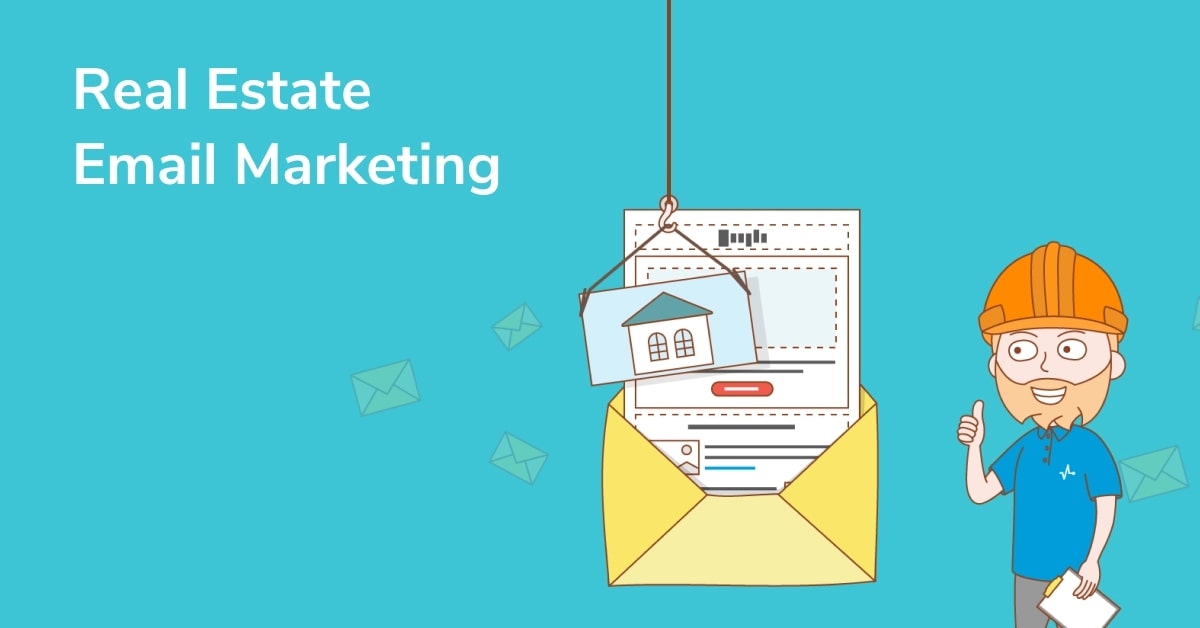
First and foremost, consider why you should rely on email marketing for your real estate business. Email marketing will benefit you as a real estate agent in the following ways:
- Collect a database. to gather interested leads, use website subscription forms or provide special bonuses in exchange for users’ email addresses.
- Show your expertise. Demonstrate your expertise by sending out digests to your subscribers with the current trends in your new blog content.
- Increase sales. Since 93 percent of users prefer to contact by email, discounts placed there can reach the buyer sooner.
- Automate your routine. Email marketing allows you to create an email series that is triggered by particular user activities such as registering on your website, browsing your real estate listings, asking for the property price, or scheduling a house tour.
- Build relationships. Build trusting relationships with clients by segmenting your audience and sending them unique offers to demonstrate that you care about each subscriber, which will undoubtedly increase user loyalty to your company.
Types of Marketing Emails For Realtors

Now that we’ve discussed how email can help your real estate business, let’s talk about what kind of emails to send. Begin your email marketing strategy by deciding which emails to send and when to send them. You must be organized and apply a strategy - plan it out - and then you will be able to maintain a regular schedule:
1. The “Welcome to my List” Email
When a new subscriber joins your list, send them a warm welcome email right away. Make remember to include the following in this email:
- Thank them for registering.
- Introduce yourself and explain why you are an outstanding real estate agent.
- Discuss the kind of emails you’ll send and how frequently you’ll send them (for example, “I’ll send valuable information about latest listings straight to your inbox every Tuesday”).
- Finish with a call-to-action (for instance, “Schedule a phone meeting now” or “Download your free neighborhood guide here”).
2. The Newsletters Email
The newsletter email is the same as your regular email. You can further target this mail to buyers or sellers based on your clients. The newsletter’s objective is to establish trust with your audience by giving relevant, useful, and informative content on a regular basis. Remember the following when producing a newsletter:
- Always provide the subscriber something helpful and actionable.
- Choose content that is easily shared. Choose themes and provide advice that your reader will want to share with others.
- Concentrate on the audience. Your newsletters aren’t about stroking your ego; they’re about helping your audience in achieving their goals.
Not sure what topics you should address in your newsletters? Here are a few ideas:
- Newest listings
- Market trends
- How to woo sellers
- How to sell your home fast
- Local neighborhood tips
- Home loan advice
- Home decorating tutorials
3. The “Buyers” Email
If you are a buyer’s agent, you should send customized emails to your buyers. You can cover a wide range of themes in your emails, including:
- How to negotiate with sellers
- Brand new listings (including listing videos)
- Neighbor and community reviews
- Financing tips
- Exciting happenings in town
- How to purchase a new home as a first time buyer
- Open house invitations
4. The “Sellers” Email
Do you primarily work with sellers? You can send specialized emails to your seller clients with information such as:
- How much other homes in the region have sold for recently
- Home maintenance and renovation tips
- Why they should select you to represent the sale of their home
- How to raise the value of a house
- Testimonials
5. The Drip Email Sequence
A drip sequence is a series of automated emails sent to your target audience over a set period of time, such as a week or a month. Drip emails marketing are typically intended to educate your email subscriber about a particular topic, such as how to negotiate, whether to purchase a house or condo, or how to stage a house to sell on a shoestring budget.
Drip sequences can be presented as an email course and used as an incentive for people to sign up for your email list.
5 Real estate email ideas for your inspiration
1. A Warm welcome for new subscribers
Introduce yourself and express your gratitude to a subscriber for joining your email list. Tell them what to expect from your emails and how frequently they can expect to hear from you. You can also walk your customers through your service, introduce them to your representatives, and show them how to get started.
Take a look at the welcome email that Compass delivered to their new subscribers. The business provides all required information for subscribers to begin using their service: how to look for interesting locations, how to select an agent, and how to determine which house will be the best option for the customers.
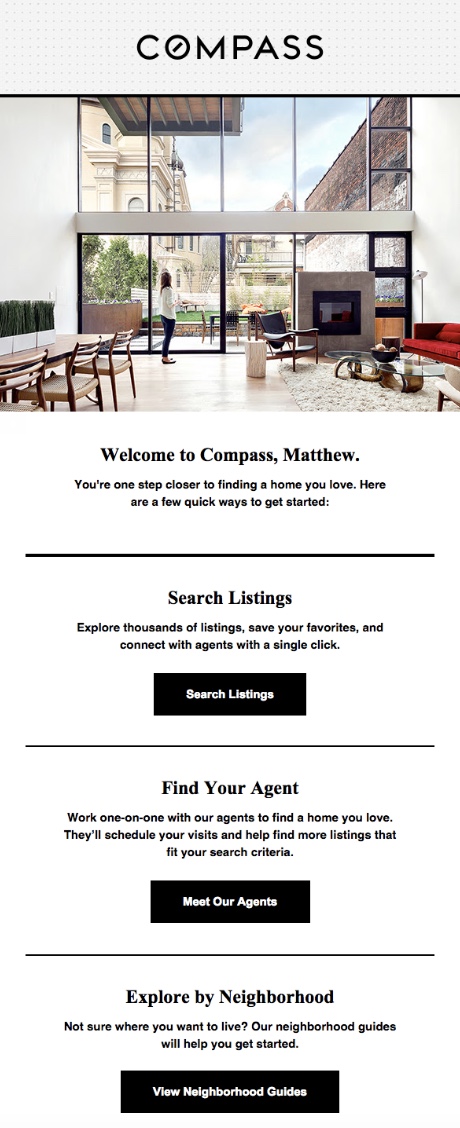
2. Personalized reminders
Targeted emails are sent to a specific subset of your audience based on their geography, purchasing history, or income. Because of the high level of personalisation, reminder emails can increase open rates and develop a closer relationship with your readers.
Consider the following real estate email example depending on the user’s surfing history. Zillow created it based on prior searches and stored locations by users.
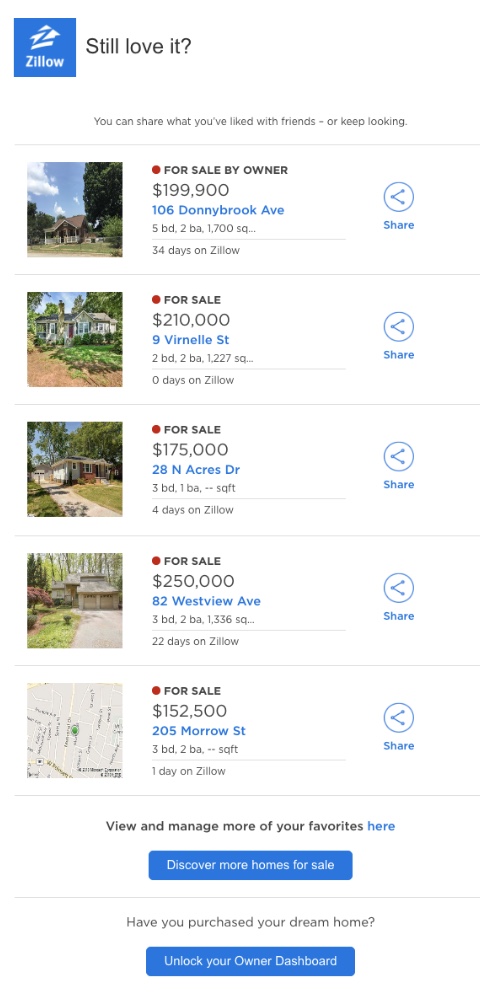
3. Emails with useful tips
Zillow also gave some real estate value — the company supports customers in assessing the affordability of the property by allowing users to estimate the worth of the property on their site.
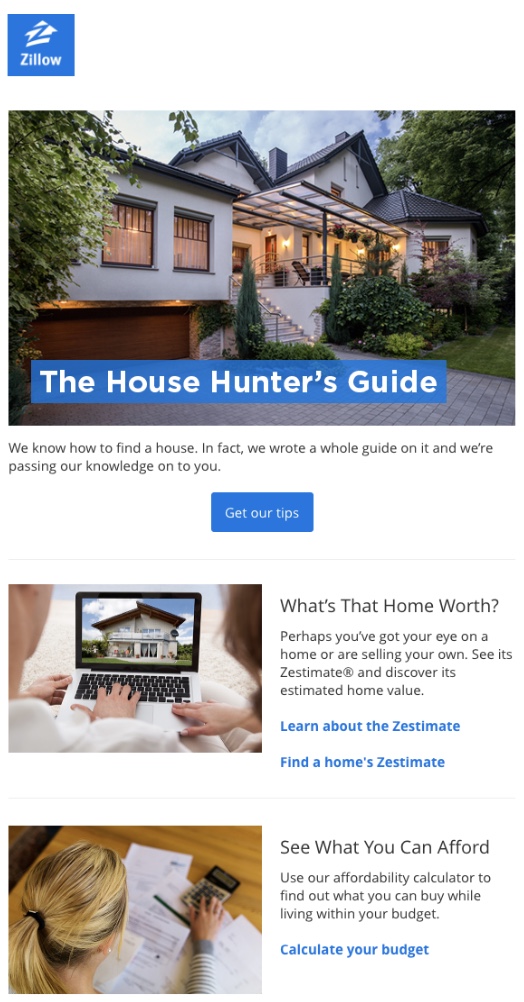
4. Regular digests
With regular digests, you can keep your subscribers up to date on the newest developments in the real estate industry. Include expert interviews, provide news, or share popular blog pieces.
Premier Agent, for example, nails it in the following ad with their digest. The email contains real estate agent-friendly tips, expert interviews, and invites to offline and online events.
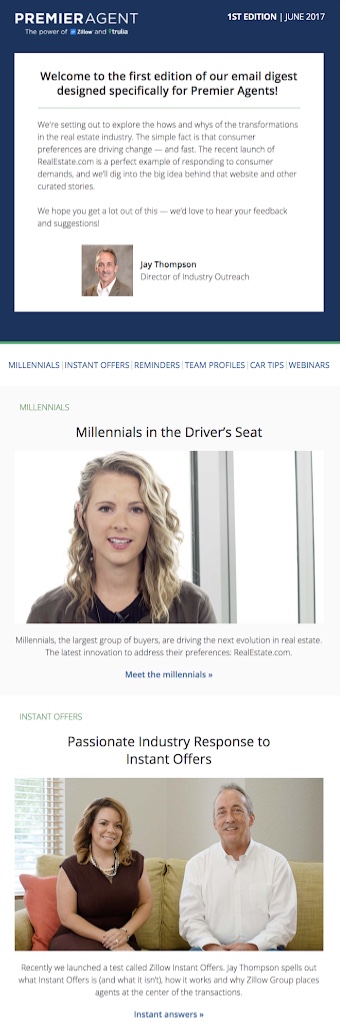
5. Milestone emails
The purchase or sale of real estate is not the only occasion to congratulate your subscribers. Sending triggered milestone emails is a great way to interact with your subscribers by thanking them for using your service or reminding them of communication anniversaries.
Premier Agent, for example, complimented their subscription real estate agent on their 50th review and offered helpful ideas for improving future evaluations.
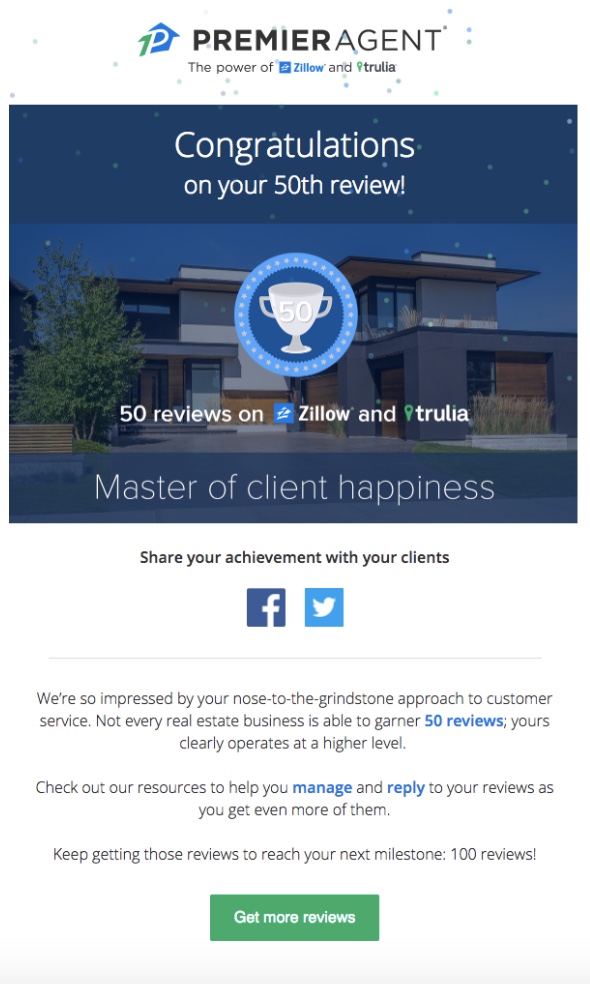
How realtors can get started with email marketing
Step 1: Define Your Audience

Email is a great tool for engaging customers, building relationships with new prospects, and bringing in new deals. All of these advantages, however, are contingent on your understanding of your target audience.
Broad, generic content sent to a large list of various contacts will not work, therefore it is critical that you take the time to better understand who you are addressing and what they need.
So how can you identify your audience? Here are some questions you need to answer:
- The Demographics. The first step is to learn the fundamentals. What job titles, levels of seniority, ages, and general qualities do your target prospects have in common? Nothing is universal, but attempt to gain a sense of how the group functions.
- What are their issues? What are the challenges, problems, or questions that these people have in common? Are they concentrating on the location? What is the cost? What is the situation? Are there any additional factors that commonly come up in sales conversations? Knowing the answers to these questions can help your emails convey your company’s image to your target audience.
- Where do they get their information? Where do these folks turn to the internet for answers to their inquiries and solutions to their problems? Learn about the commercial real estate websites they visit, the social media platforms they utilize, and the blogs they read.
By knowing the three points, you can convey a more detailed portrait of your ideal customer, and your emails can be personalized better for their needs.
Step 2: Segment Your Contacts
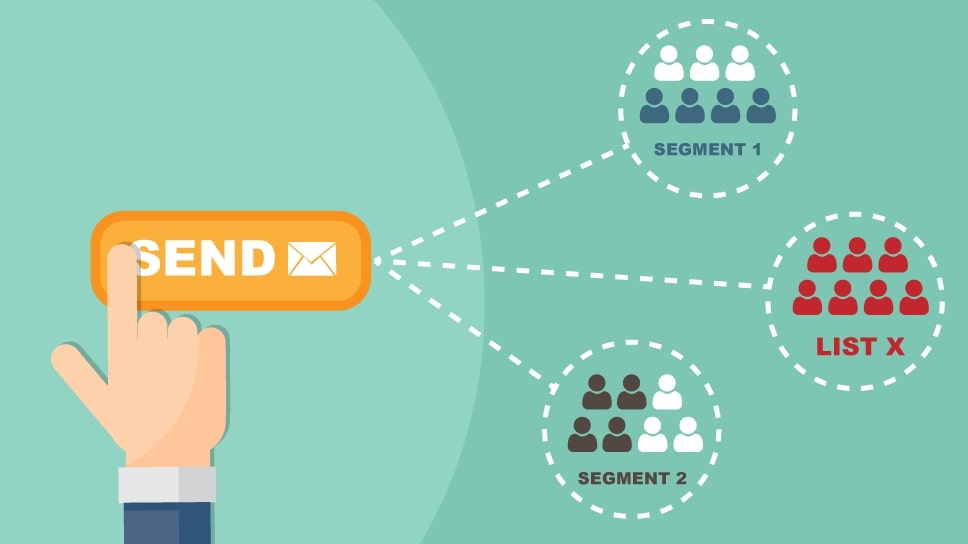
Broad, generic emails sent to a large list of various contacts no longer work today, therefore it’s critical that you take the time to learn more about who you’re contacting and what their interests are.
By far one of the most effective things you can do is segment your contact list. It is, however, the most difficult and most time-consuming goal to accomplish. However, if done correctly, segmentation of your contact list can assist you in identifying critical targets within parts of your list and reaching out to them with content that resonates.
Your massive one-size-fits-all email list could include hundreds or even thousands of prospects, each with their own set of needs. Sending an update regarding specific attributes to all of them does not work as well as segmenting and sending tailored emails.
To segment your contacts effectively, break your list up by specific categories such as:
- Organization Type
- Location
- Interest Level
- Job Function
- Target Property
A decent list may be something like “Retail Buyers – Warm Prospects – Boston.” The naming conventions will vary based on your system and how you like to organize things, but the objective here is to separate things off such that they are easily searchable and highly targeted. List segmentation is to tailor content and messages to each section.
Prospects in Boston and Washington, DC deal with a variety of challenges on a daily basis and will respond to messages in your emails in a variety of ways. The same holds true for individuals in various sorts of organizations, job roles, and levels of seniority.
Step 3: Manage Your List
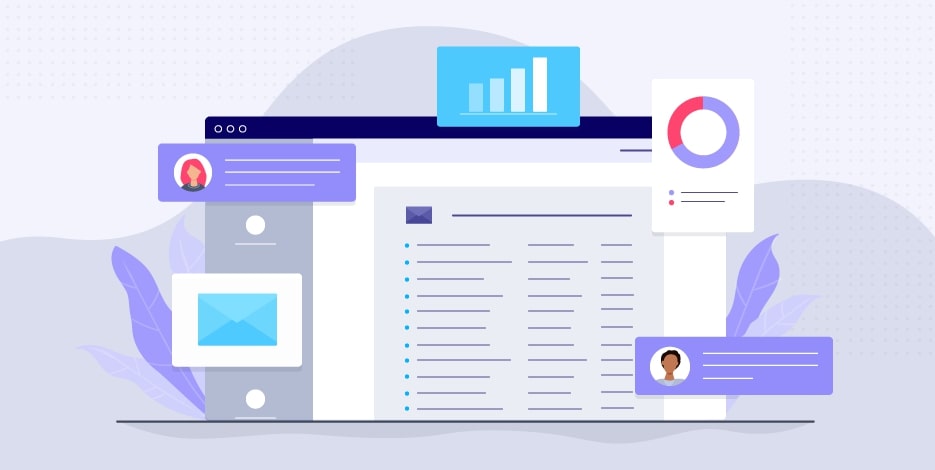
A good email list isn’t necessarily wordy, but it’s focused, primed, and kept up to date. It is preferable to have 500 contacts who have read your emails, interacted with your material, and actively sought out your expertise over a list of 5,000 contacts who have never heard of you or have not opened an email in over a year.
List management is critical for maximizing the return on your emails, maintaining high delivery rates, and knowing exactly what to expect when you reach out to your list. This is what it entails:
- Clean your lists on a regular basis. Emails will bounce if an email address is no longer valid. Those emails are frequently stored in the database for months or even years after they are no longer accessible. When you notice a bounce, remove them.
- Unsubscribes should be removed. If someone unsubscribes, they should be removed from your email list. As spam and privacy regulations tighten, it’s more crucial than ever to stop emailing these people.
- Update your subscriber’s status. There is no such thing as a completely lost contact, but there are some boundaries to be aware of. If someone hasn’t responded to an email or engaged with your emails in more than a year or so, consider removing them or launching a cold-nurture campaign to try to re-engage them one more time before deletion.
Read more: Why Should you Clean your Email List?
Step 4: Create a well-structured email
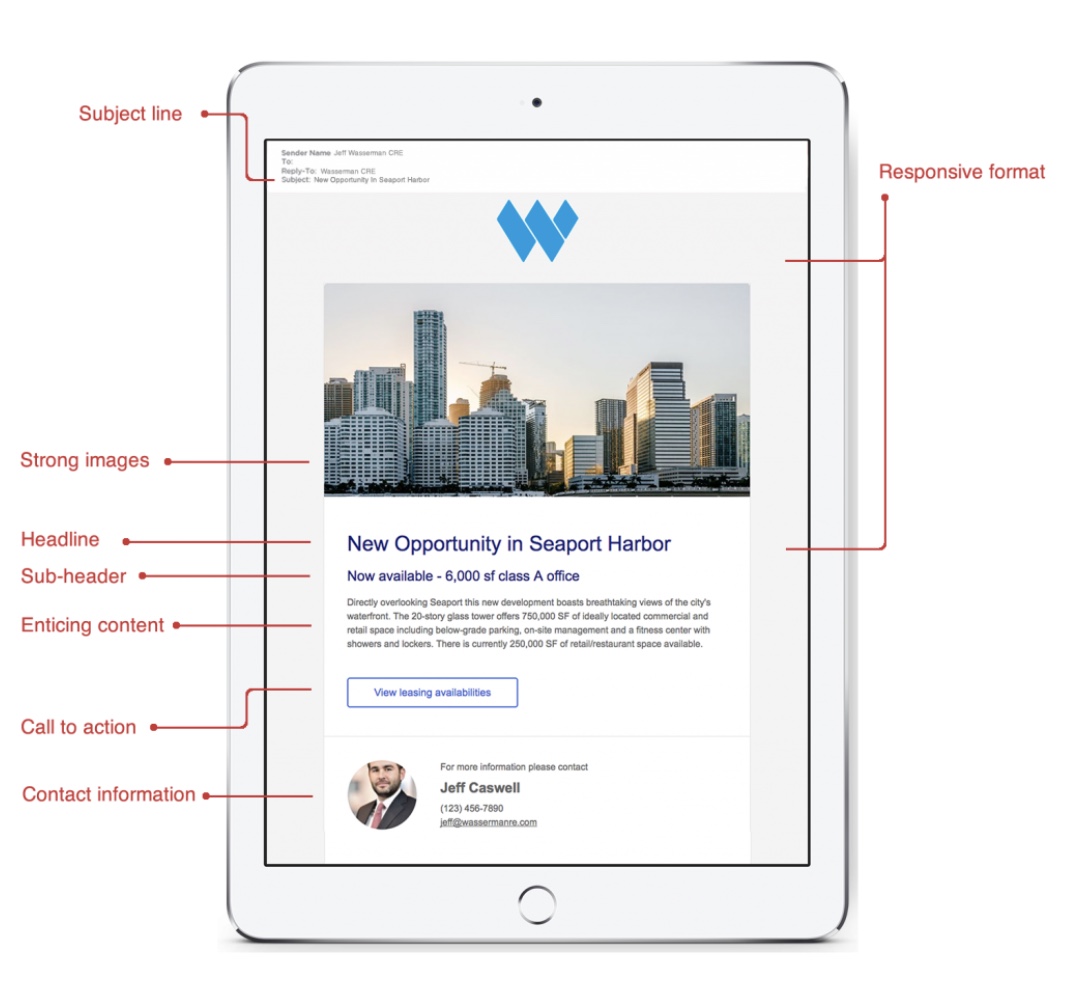
A good commercial real estate email template for your property marketing efforts should include the most crucial aspects that assist create impact, are easy to comprehend, and push your prospective tenants to act.
1. Subject Line
When attempting to increase open rates, the subject line is the first impression you make on prospects and the initial call to action that encourages subscribers to take action.
2. Strong Images
Visuals are extremely vital in boosting engagement with any online content, particularly property listing blasts. A great lead image at the top of your email will grab readers’ attention and direct them down the page.
3. Headline
Your headline will make it apparent what your email is about, such as current property listings, local market recommendations, or general information about a building or a certain location.
4. Sub-header
Subheaders in an email help to break up text and keep it from becoming too long. If you intend to include many property listings, articles, and calls to action, it should be separated up for simple scanning, especially on a mobile device with a lot of scrolling.
5. Valuable Content
Your content should be more than a synopsis of the property; it should highlight unique benefits that the property has to offer.
Drive traffic to your property listings by writing compelling material that gives people a cause to click. Keep it short and to the point, with a clear objective, and you’ll get considerably more engagement out of inboxes.
6. Call to Action
Add a call to action button or link that stands out from the rest of the content and directs potential tenants and investors to take action. Buttons outperform text links in visual emails, and characteristics such as size, shape, and color can all capture more attention and drive more clicks to your property websites.
7. Contact Information Make it simple for your contacts to reach you by including their name, title, phone number, and email address. Also, wherever possible, provide headshots to add a personal touch to your messages.
Step 5: Write a perfect subject line
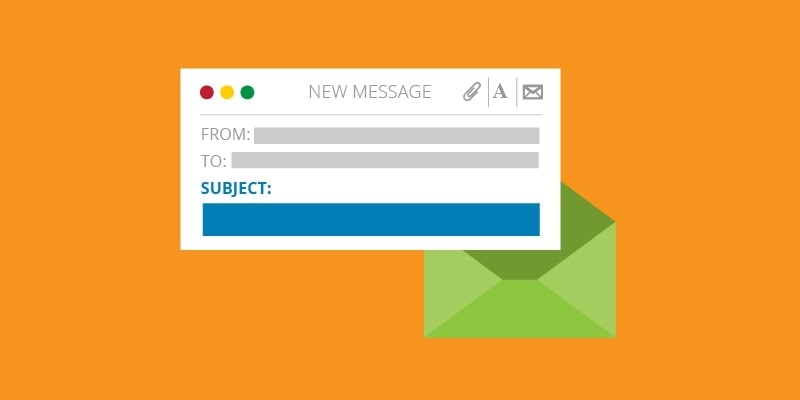
Whether you want to get a good first impression from a new prospect or entice a long-term client to re-engage, your email must have enticing commercial real estate subject lines that stand out in their crowded inboxes, pique interest, encourage the recipient to open, and motivate them to take the desired action.
You can get a better understanding of which subject line methods perform best for different categories of your audience and different types of emails by evaluating the open and click rates of your prior campaigns.
Step 6: Write Specific, Relevant, and Detailed Content

While brevity is advised, especially for mobile-optimized campaigns, it is equally critical to provide precise, specific data that indicate exactly why your commercial real estate email is of interest or use to the reader:
- Size. When sending property-specific emails, mentioning the square footage in the subject line might immediately appeal to readers who are seeking for places of that size. Combine this strategy with a specific list to maximize its effectiveness. One caveat: Don’t start with the figures, as this may put off readers.
- Location/Region. If the property is in a very hot area or one with few open spaces, putting that in the subject line can communicate the sense of a rare opportunity.
- Interest/Competition. You can create a sense of urgency to increase engagement by emphasizing scarcity (for example, “X spaces left”) or high levels of interest (for example, “X leases signed just today”).
- Updates/Progress. Mentioning interesting new renderings, before and after images, or visual progress updates may be extremely engaging and create anticipation. This is especially effective if you have a targeted list of prospects who have expressed interest in a house that is being renovated or a new house that is being built from the bottom up.
Step 7: Send your email at the right time

When it comes to email send timings, there are a few pieces of “common knowledge.” After all, if you can bring your email in front of prospects when they are less busy and more likely to open it, they will be more likely to respond. But, with so much conflicting information available, how can you determine when the optimal time is?
Here is one thing to keep in mind when evaluating the send timing for your email: Avoid the competition.
Business emails, according to conventional belief, should be sent between 9 a.m. and 6 p.m. on Tuesdays and Thursdays. Avoid Mondays, when people are stressed, and Fridays, when people are tired. However, because everyone does it, the vast majority of business emails are delivered between 11 a.m. and 4 p.m. on Tuesdays, Wednesdays, and Thursdays. That’s a lot of traffic for the middle of the week.
Step 8: Improve Deliverability

Nothing is more infuriating than creating an email, fine-tuning it for your target audience, and then discovering that a large percentage of individuals did not even receive it. There are some things you can do to guarantee your emails go to where they belong, including some easy, non-technical steps you can take right now to lower the probability of their being marked as spam and increase the amount of emails that get into the inbox and not the trash folder.
Check your Sender Score
Did you know that ISPs can view and track every email you send to ensure you don’t pose a high spam danger level? However, this is a good thing because it implies we can view the data.
Sender Score provides a platform that will share your performance when sending emails and then present you with a score ranging from 1 to 100. This score is calculated using a variety of factors, including:
- Recent complaints
- Blacklists
- Infrastructure (how your emails are sent)
- Sender rejection notices
- Message filtering levels
- Unknown users
- Spam traps
While some of this may indicate technical issues that would necessitate the assistance of a third party, reviewing your Sender Score helps verify that you are aware of the difficulties and are doing your utmost to fix them.
Improving Your Deliverability Rates with Better Send Strategies
Based on when you send your emails, who you send them to, and how those emails are validated, there are numerous things you can do to improve sender ratings and deliverability. Some basic things you can do right now to solve these difficulties are as follows:
- Send Consistently. When emails are sent in unpredictable bursts, you may have greater rejection rates and a worse overall sender score. Consistently sending over time is a key approach to avoid this.
- Make Certain That Your Contacts Have Opted In. The last thing you want is someone marking your email as spam. If a recipient is unsure why they are receiving an email from you, this is a bad indicator because it can quickly lead to high spam rates and eventual blacklisting. To circumvent this problem, only transmit to persons who have requested information from you, and employ a double opt-in and email confirmation process.
- Clean Your List on a Regular Basis. Remove bounced emails, unsubscribes, as well as other non-deliverables from your list on a regular basis. When you send to these addresses and they bounce back, it may cause a block or filters to be applied to all of your emails. Use an email validation tool to check for inactive accounts, duplicates, or old domains.
Email is one of the most successful techniques for a commercial real estate marketing strategy. That is why it is so damaging to send emails that may increase your spam rate or place you on a blacklist, lowering your deliverability rates. To avoid this, be alert, thoroughly trim your list, and transmit intelligently.
Step 9: Develop a Follow Up Strategy
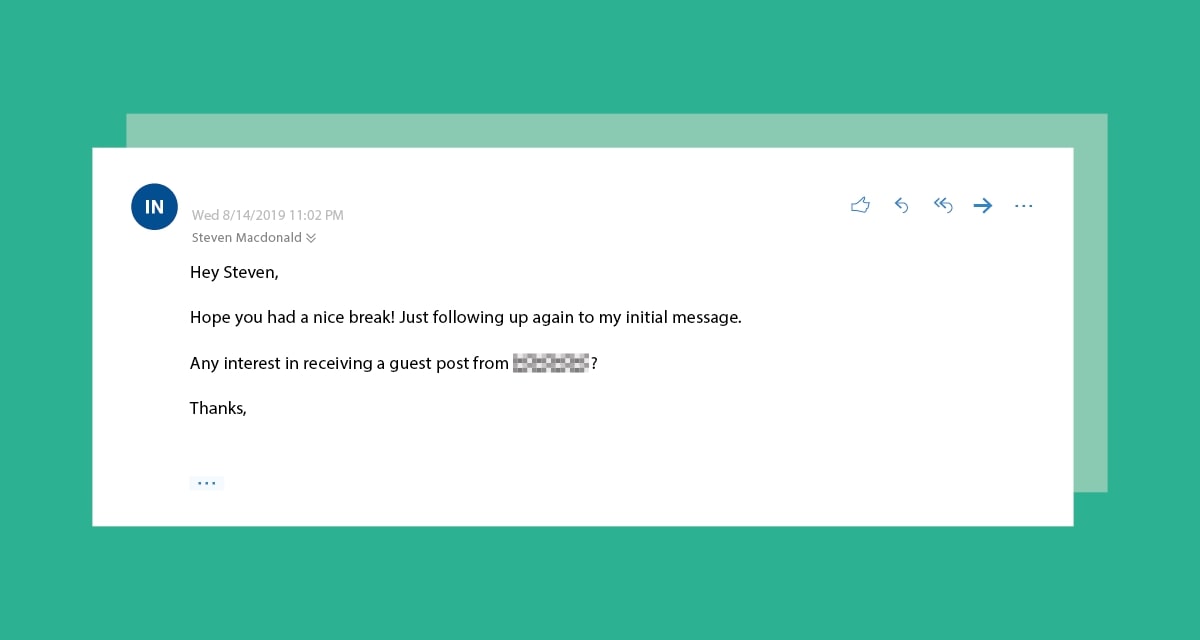
Remember, if nothing else, that follow-up closes deals. A lack of follow-up can sink even the most robust and effective email marketing initiatives.
The average email is opened 91 percent of the time within a day of being sent. That indicates that after a whole day, only 9% of emails get opened. They are lost in mismanaged inboxes and are never seen again.
While it is easy to think that these lost emails are being deliberately disregarded, the plain truth is that the average email user receives between 100 and 150 emails every day. If something is not thought necessary during a very hectic period of time, it will soon slide into the abyss. When prospecting by email, a good follow-up approach is essential.
According to a recent Yesware survey, more than half of the initial replies arrived after the third email was sent, and more than 30 percent were not received until the seventh or later email.
It may take multiple follow-ups over several weeks to receive an answer. Don’t be too quick to give up. Other things you should do to strengthen your follow-up game are as follows:
Automate your emails
When calling cold prospects or those you haven’t spoken with in a while, automation helps assure better long-term follow-up using scheduled sequences. Those that can be updated depending on engagement perform even better, elevating prospects who open or click an email as opposed to those who do not.
Vary your outreach times
All of the best practices in the world will be useless if your target does not open the email at the specified time. If you don’t receive responses during standard business hours or on weekdays, try varying your outreach time. Try weekends, late evenings, or off hours to see if there is a gap in their schedule that would make a response more likely.
Resend to non-openers
If someone does not open your email, it does not necessarily imply that they are uninterested in it. They could have been out of the office, missed the email, or were too preoccupied to read or respond when it was received. Because most individuals do not empty their inboxes, it is unlikely that it will be seen again. To counteract this, resend emails to non-openers with a new subject line a week later.
Step 10: Track your results

Finally, in order for your email marketing efforts to be productive, you must build a real estate marketing report to determine what works and what does not. Surprisingly, a big majority of commercial real estate professionals rely on gut feelings about whether business is doing better or worse to evaluate whether their efforts are effective.
However, it is critical to understand not only what works, but also why it works, when it works, and what modifications had the biggest positive impact.
Specifically, you should:
- Track critical email metrics. For each email you send, you should know the open rate, reply rate, and click rate on any links contained in your message.
- Segment by email type. Personal emails sent from your CRM will have different data than marketing emails and newsletters delivered via autoresponder or marketing solutions. Measure each separately in order to make more informed decisions based on the data.
- A/B test your headlines. When sending emails to huge groups, don’t be hesitant to experiment with alternative subject lines. If you’re using an autoresponder to contact hundreds of prospects at once, test out a few different headlines to determine which ones work best. Software that allows for A/B testing in a single batch is much more efficient because it allows you to leave all variables static except the subject line.
- Observe changes over time. Keep track of how your metrics vary over time as you make adjustments to your campaigns.
Best Email Marketing Software For Realtor Email Marketing
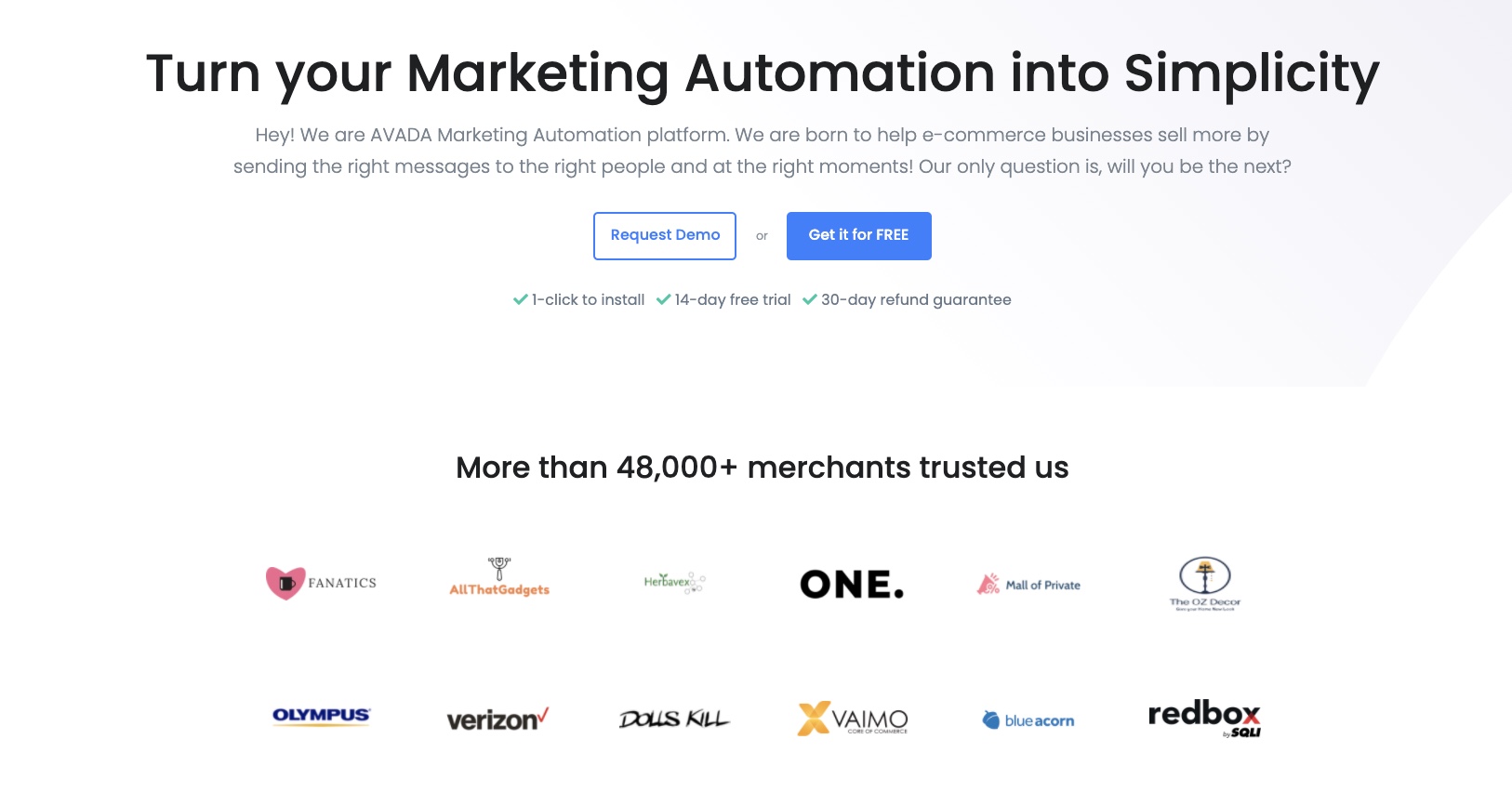
AVADA Marketing Automation is a very powerful email marketing tool that provides you with all the features needed to implement the knowledge you’ve learnt in this article. This feature-rich tool will help you run and manage your email campaigns very effectively.
Final words
That’s it! I hope this article has provided you with valuable information about how to get started with realtor email marketing. Please feel free to leave comments below for further discussion on this topic!
New Posts






